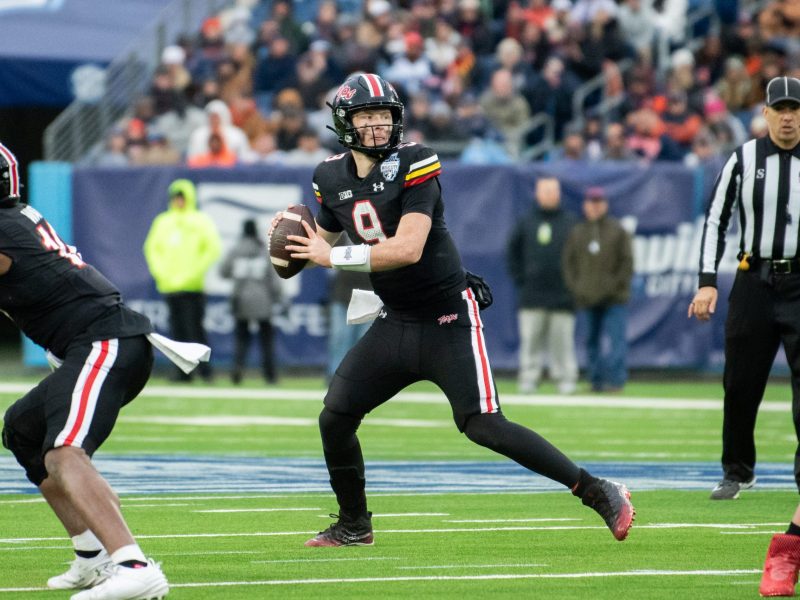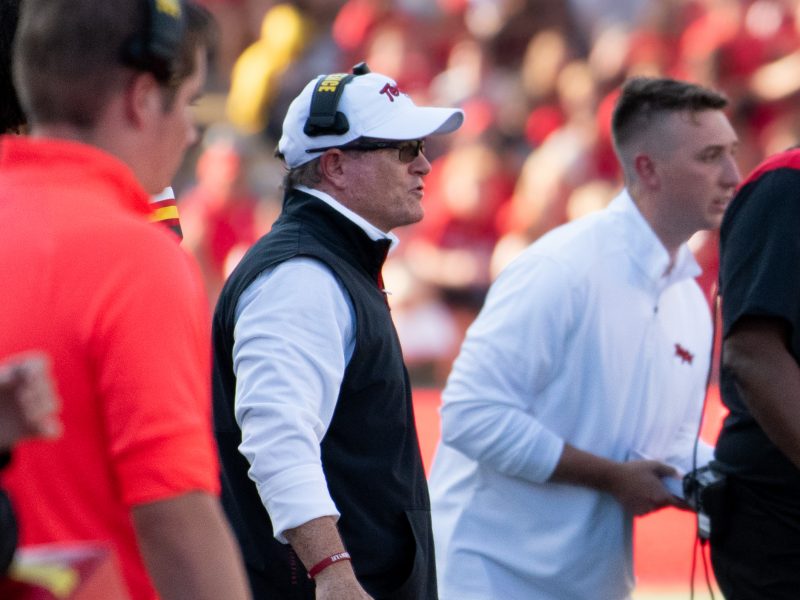Watching Terrapins football head trainer Wes Robinson stare into a concussed Caleb Rowe’s eyes before pushing him back toward the field is sickening.
After dancing around exactly when Rowe suffered the concussion during his postgame press conference Saturday, interim coach Mike Locksley confirmed Sunday what everyone else already suspected: Rowe suffered the concussion while scrambling late in the second quarter before he came back in.
READ MORE: Locksley confirms when Rowe suffered concussion
Locksley said Rowe was evaluated on the sideline, which can be seen on the Big Ten Network’s broadcast, but about a minute later, Rowe was inexplicably allowed to re-enter the game.
He went on to play six snaps, including a scramble on his first play after returning. While he didn’t take a hit on the play, his head dragged along the turf — hardly something that should be happening right after suffering a concussion.
I’m not sure who’s directly responsible for Rowe playing after his concussion. But whoever was should be stripped of whatever title gave them the authority to let it happen. Sending a player back in after taking a blow to the head and calling for a sub is unacceptable.
The Big Ten is supposed to have an independent athletic trainer in the replay booth who looks out for concussions and can contact officials on the field. Sitting in the press box five stories up, it was clear to me immediately after the play that Rowe had probably suffered a concussion.
So why did it take Rowe complaining of a headache at halftime to finally keep him off the field? Why was he rushed back into the game a minute after suffering his concussion? Why didn’t the evaluation Robinson gave Rowe prevent the signal-caller from playing?
This is by no means an issue exclusive to the Terps. Oklahoma had a similar situation Saturday. Quarterback Baker Mayfield also suffered a head injury during the second quarter of his game and remained in the game until the break. He wasn’t ruled out until he admitted to doctors that he had a headache at halftime, according to ESPN.
Then yesterday in an NFL game, St. Louis Rams quarterback Case Keenum was whipped to the ground, causing his head to bounce off the turf. He was down for several seconds and appeared visibly shaken but was never removed from the game. After the contest, it was announced he had a concussion.
The difference between these situations and the Terps’, though, is that Rowe was initially pulled from the game and evaluated. So where some of the blame can fall on the quarterbacks for not removing themselves in the other instances, the same can’t be said about Rowe.
He motioned to come off, clearly alerting the staff that he had suffered a head injury. And despite being evaluated, he was allowed to return.
I spoke with multiple health professionals, who agreed it would’ve been safer to err on the side of caution and wait to conduct more thorough testing inside the locker room.
They added that pressure to get the player back into the game can be tough on the evaluators. Plus, one professional said a lot of the responsibility falls on the player to admit their symptoms during the evaluation.
While we’ll likely never know what was said between Robinson and Rowe, we do know Rowe voluntarily pulled himself from the game, unlike Keenum and Mayfield. He was willing to admit he was shaken.
How much harm could be done by leaving Rowe, the backup quarterback on a then-2-8 team, on the sidelines for the final three minutes so he could go through a longer evaluation during the break? Surely less than him hitting his head a second time after returning to the field prematurely.
On Sunday, Locksley said the Terps didn’t learn of the concussion until a second evaluation during halftime after Rowe complained of a headache.
Given adequate recovery time, a single concussion usually doesn’t have long-term effects on an individual’s health. But playing with a concussion is extremely dangerous.
Repeated blows to the head of that nature can cause brain swelling and lasting brain damage. And as the past few years have shown, former players with a history of head injuries have a disturbing propensity toward taking their own lives.
So Rowe scrambling outside the pocket just minutes after he initially suffered the concussion put him in harm’s way. Fortunately, no players hit Rowe during his six-play return to the field.
Saturday’s situation is just the latest in a series of instances where football teams mishandled a player who had a head injury. The Terps’ mismanagement didn’t even make national headlines, showing how numb we have come as a society to football players and concussions.
A movie on football concussions starring Will Smith is set for release next month, and the NCAA and NFL alike have stressed the importance of more stringent concussion protocol. As a society, it seems as though we’re making strides.
Yet in a span of two days, three quarterbacks continued playing with concussions. The Terps contributed to that.
Someone needs to put their foot down. The Terps now have that opportunity. Do something about it.



